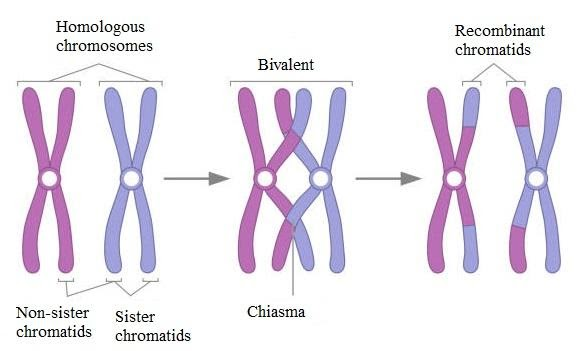
Which of the following is correct about bivalent?
(i) Bivalents are tetrads.
(ii) A bivalent means \[4\] chromatids and \[2\] centromeres.
(iii) One bivalent consists of \[2\] homologous chromosomes.
(iv) Bivalents form in zygotene.
A. (i), (ii), (iii), and (iv)
B. (iii) only
C. (iii) and (iv)
D. (iv) only
Answer
501.9k+ views
Hint: A bivalent is one pair of tetrads that is associated with a pair of homologous chromosomes. The formation of a bivalent occurs during its first division. Bivalent is the association of two replicated homologous chromosomes.
Complete answer:
Option A (i), (ii), (iii), and (iv):
Bivalent occurs in the first division of meiosis. A bivalent is the association of two replicated homologous chromosomes having exchanged DNA strands. Bivalent is one pair in a tetrad. Bivalent is an association of two replicated chromosomes.
Option A is the correct answer.
Option B (iii) only - One bivalent consists of \[2\] homologous chromosomes: Even though this fact is true about bivalent. But the other options are also true about bivalent. One bivalent consists of \[2\] homologous chromosomes. The structure visible by microscopy is called bivalent. Bivalent are tetrads and they have two chromatids and \[2\] centromeres. One bivalent consists of \[2\] homologous chromosomes and these bivalents form in zygotene. These are also the features of Bivalent.
Option B is the wrong answer.
Option C (iii) and (iv): Even though both (iii) and (iv) are true in respect of bivalent. The other points are also true relating to bivalent. One bivalent consists of \[2\] homologous chromosomes. Thus, it is true that one bivalent contains two chromosomes that are visible under microscopy. Bivalents form in zygotene. This is also a true fact that \[30\] bivalents are formed in the zygotene stage. Bivalent is tetrads. Since other points are also true this option is wrong.
Option C is the wrong answer.
Option D (iv) only: Bivalents form in zygotene. This is a true fact. Each bivalent is formed by fusing four chromosomes. \[30\] bivalents are formed during the zygotene stage. This option is wrong because the other points given are also related to bivalent. Bivalent are tetrads and they have two chromatids and \[2\] centromeres. One bivalent consists of \[2\] homologous chromosomes. Hence these are also correct regarding bivalent we can’t say only (iv) is correct regarding bivalent.
Option D is the wrong answer.
So, Option A is the correct answer.
Note:
Bivalents is one pair of chromosomes in a tetrad. Hence, we can say that bivalents are tetrads. A bivalent means \[4\] chromatids and \[2\] centromeres. One bivalent consists of \[2\] homologous chromosomes.
Bivalents form in zygotene. \[30\] bivalents are formed during zygotene.

Complete answer:
Option A (i), (ii), (iii), and (iv):
Bivalent occurs in the first division of meiosis. A bivalent is the association of two replicated homologous chromosomes having exchanged DNA strands. Bivalent is one pair in a tetrad. Bivalent is an association of two replicated chromosomes.
Option A is the correct answer.
Option B (iii) only - One bivalent consists of \[2\] homologous chromosomes: Even though this fact is true about bivalent. But the other options are also true about bivalent. One bivalent consists of \[2\] homologous chromosomes. The structure visible by microscopy is called bivalent. Bivalent are tetrads and they have two chromatids and \[2\] centromeres. One bivalent consists of \[2\] homologous chromosomes and these bivalents form in zygotene. These are also the features of Bivalent.
Option B is the wrong answer.
Option C (iii) and (iv): Even though both (iii) and (iv) are true in respect of bivalent. The other points are also true relating to bivalent. One bivalent consists of \[2\] homologous chromosomes. Thus, it is true that one bivalent contains two chromosomes that are visible under microscopy. Bivalents form in zygotene. This is also a true fact that \[30\] bivalents are formed in the zygotene stage. Bivalent is tetrads. Since other points are also true this option is wrong.
Option C is the wrong answer.
Option D (iv) only: Bivalents form in zygotene. This is a true fact. Each bivalent is formed by fusing four chromosomes. \[30\] bivalents are formed during the zygotene stage. This option is wrong because the other points given are also related to bivalent. Bivalent are tetrads and they have two chromatids and \[2\] centromeres. One bivalent consists of \[2\] homologous chromosomes. Hence these are also correct regarding bivalent we can’t say only (iv) is correct regarding bivalent.
Option D is the wrong answer.
So, Option A is the correct answer.
Note:
Bivalents is one pair of chromosomes in a tetrad. Hence, we can say that bivalents are tetrads. A bivalent means \[4\] chromatids and \[2\] centromeres. One bivalent consists of \[2\] homologous chromosomes.
Bivalents form in zygotene. \[30\] bivalents are formed during zygotene.

Recently Updated Pages
Master Class 11 Economics: Engaging Questions & Answers for Success

Master Class 11 English: Engaging Questions & Answers for Success

Master Class 11 Social Science: Engaging Questions & Answers for Success

Master Class 11 Biology: Engaging Questions & Answers for Success

Class 11 Question and Answer - Your Ultimate Solutions Guide

Master Class 11 Business Studies: Engaging Questions & Answers for Success

Trending doubts
10 examples of friction in our daily life

One Metric ton is equal to kg A 10000 B 1000 C 100 class 11 physics CBSE

Difference Between Prokaryotic Cells and Eukaryotic Cells

1 Quintal is equal to a 110 kg b 10 kg c 100kg d 1000 class 11 physics CBSE

Explain zero factorial class 11 maths CBSE

What is a periderm How does periderm formation take class 11 biology CBSE




